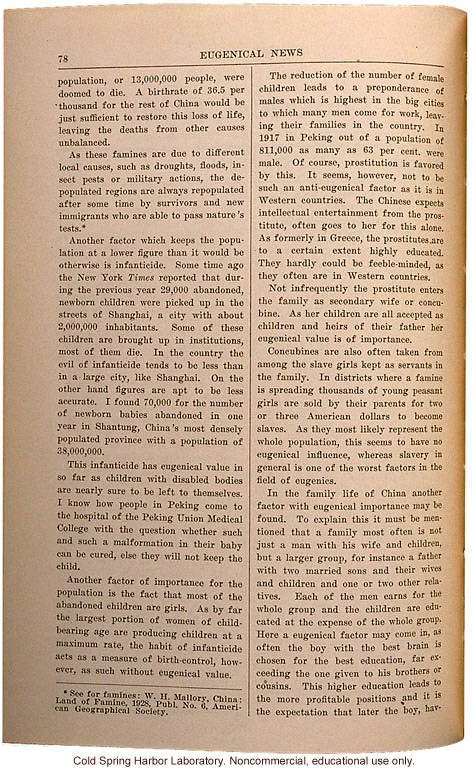78 Eugenical News
population, or 13,000,000 people, were doomed to die. A birthrate of 36.5 per thousand for the rest of China would be just sufficient to restore this loss of life, leaving the deaths form other causes unbalanced.
As these famines are due to different local causes, such as droughts, floods, insect pests or military actions, the depopulated regions are always repopulated after some time by survivors and new immigrants who are able to pass nature's tests.*
Another factor which keeps the population at a lower figure than it would be otherwise is infanticide. Some time ago the New York [italics]Times[end italics] reported that during the previous year 29,000 abandoned, newborn children were picked up in the streets of Shanghai, a city with about 2,000,000 inhabitants., Some of these children are brought up in institutions, most of them die. In the country the evil of infanticide tends to be less than in a large city, like Shanghai. On the other hand figures are apt to be less accurate. I found 70,000 for the number of newborn babies abandoned in one year in Shantung, China's most densely populated province with a population of 38,000,000.
This infanticide has eugenical value in so far as children with disabled bodies are nearly sure to be left to themselves. I know how people in Peking come to the hospital of the Peking Union Medical College with the question whether such and such a malformation in their baby can be cured, else they will not keep the child.
Another factor of importance for the population is the fact that most of the abandoned children are girls. As by far the largest portion of women of childbearing age are producing children at a maximum rate, the habit of infanticide acts as a measure of birth-control, however, as such without eugenical value.
The reduction of the number of female children leads to a preponderance of males which is highest in the big cities to which many men come to for work, leaving their families in the country. In 1917 in Peking out of a population of 811,000 as many as 63 per cent. were male. Of course, prostitution is favored by this. It seems, however, not to be such an anti-eugenical factor as it is in Western countries. The Chinese expects intellectual entertainment from the prostitute, often goes to her for this alone. As formerly in Greece, the prostitutes are to a certain extent highly educated. They hardly could be feeble-minded, as they often are in Western countries.
Not infrequently the prostitute enters the family as a secondary wife or concubine. As her children are all accepted as children and heirs of their father her eugenical value is of importance.
Concubines are also often taken from among the slave girls kept as servants in the family. In districts where a famine is spreading thousands of young peasant girls are sold by their parents for two or three American dollars to become slaves. As they most likely represent the whole population, this seems to have no eugenical influence, whereas slavery in general is one of the worst factors in the field of eugenics.
In the family life of China another factor with eugenical importance may be found. To explain this it must be mentioned that a family most often is not just a man with his wife and children, but a larger group, for instance a father with two married sons and their wives and children and one or two other relatives. Each of the men earns for the whole group and the children are educated at the expense of the whole group. Here a eugenical factor may come in, as often the boy with the best brain is chosen for the best education, far exceeding the one given to his brothers or cousins. This higher education leads to the more profitable positions and it is the expectation that later the boy, hav-
[left side column-width hairline rule over footnote]
[footnote]*See for families: W.H. Mallory, China: Land of Famine, 1928, Publ. No. 6, American Geographical Society.
[end]


